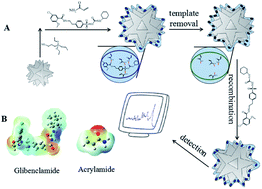Flower-like Ag coated with molecularly imprinted polymers as a surface-enhanced Raman scattering substrate for the sensitive and selective detection of glibenclamide†
Abstract
Flower-like Ag was formed by nanosheet self-assembly as a SERS-active substrate and was utilized for the preparation of flower-like Ag@molecularly imprinted polymers (MIPs) as a surface-enhanced Raman scattering (SERS) sensor. Based on the combination of the molecular imprinting technique and SERS technology, the flower-like Ag@MIPs with high sensitivity and excellent selectivity were used as SERS substrates for the detection of glibenclamide. The imprinted layer could effectively protect the flower-like Ag from oxidation and thereby may improve the stability of the SERS substrate. The intensities of the characteristic peaks obtained for the flower-like Ag@MIPs were higher than that of flower-like Ag. By applying the flower-like Ag@MIPs as an efficient and ultra-sensitive SERS platform, glibenclamide was quantitatively detected in trace concentrations as low as 1 ng mL−1. Furthermore, the SERS enhancement for the flower-like Ag@MIPs was due to the synergetic effect between electromagnetic enhancement and chemical enhancement. We believe that this reliable method can open up new opportunities for practical chemosensor or biosensor applications.



 Please wait while we load your content...
Please wait while we load your content...